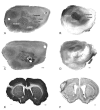Rodent models of focal stroke: size, mechanism, and purpose
- PMID: 16389304
- PMCID: PMC1144484
- DOI: 10.1602/neurorx.2.3.396
Rodent models of focal stroke: size, mechanism, and purpose
Abstract
Rodent stroke models provide the experimental backbone for the in vivo determination of the mechanisms of cell death and neural repair, and for the initial testing of neuroprotective compounds. Less than 10 rodent models of focal stroke are routinely used in experimental study. These vary widely in their ability to model the human disease, and in their application to the study of cell death or neural repair. Many rodent focal stroke models produce large infarcts that more closely resemble malignant and fatal human infarction than the average sized human stroke. This review focuses on the mechanisms of ischemic damage in rat and mouse stroke models, the relative size of stroke generated in each model, and the purpose with which focal stroke models are applied to the study of ischemic cell death and to neural repair after stroke.
Figures


References
-
- American Heart Association, Heart Disease and Stroke Statistics Update 2004.http://www.americanheart.org/presenter.jhtml?identifier=3000090.
-
- Carmichael ST. Plasticity of cortical projections after stroke. Neuroscientist 9: 64–75, 2003. - PubMed
-
- Gladstone DJ, Black SE, Hakim AM. Heart and Stroke Foundation of Ontario Centre of Excellence in Stroke Recovery. Toward wisdom from failure: lessons from neuroprotective stroke trials and new therapeutic directions. Stroke 33: 2123–2236, 2003. - PubMed
Publication types
MeSH terms
Grants and funding
LinkOut - more resources
Full Text Sources
Other Literature Sources
Medical

